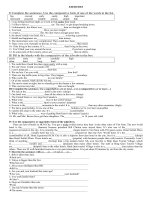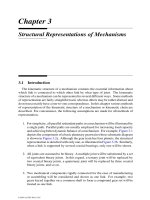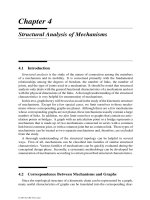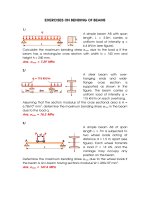Tài liệu STUDIES OF AMERICAN FUNGI, MUSHROOMS, EDIBLE, POISONOUS, ETC ppt
Bạn đang xem bản rút gọn của tài liệu. Xem và tải ngay bản đầy đủ của tài liệu tại đây (1.1 MB, 503 trang )
STUDIES OF AMERICAN FUNGI, MUSHROOMS,
EDIBLE, POISONOUS, ETC.
by
GEORGE FRANCIS ATKINSON
Professor of Botany in Cornell University, and Botanist of the
Cornell University Agricultural Experiment Station
Recipes for Cooking Mushrooms, by Mrs. Sarah Tyson Rorer
Chemistry and Toxicology of Mushrooms, by J. F. Clark
With 230 Illustrations from Photographs by the
Author, and Colored Plates by F. R. Rathbun
SECOND EDITION
[Illustration: PLATE 1.
FIG. 1 Amanita muscaria.
FIG. 2 A. frostiana.
Copyright 1900.]
[Illustration: Printer's logo.]
New York
Henry Holt and Company
1903
Copyright, 1900, 1901,
by
Geo. F. Atkinson.
INTRODUCTION.
Since the issue of my "Studies and Illustrations of Mushrooms," as
Bulletins 138 and 168 of the Cornell University Agricultural Experiment
Station, there have been so many inquiries for them and for literature
dealing with a larger number of species, it seemed desirable to publish
in book form a selection from the number of illustrations of these
plants which I have accumulated during the past six or seven years. The
selection has been made of those species representing the more important
genera, and also for the purpose of illustrating, as far as possible,
all the genera of agarics found in the United States. This has been
accomplished except in a few cases of the more unimportant ones. There
have been added, also, illustrative genera and species of all the other
orders of the higher fungi, in which are included many of the edible
forms.
The photographs have been made with great care after considerable
experience in determining the best means for reproducing individual,
specific, and generic characters, so important and difficult to preserve
in these plants, and so impossible in many cases to accurately portray
by former methods of illustration.
One is often asked the question: "How do you tell the mushrooms from the
toadstools?" This implies that mushrooms are edible and that toadstools
are poisonous, and this belief is very widespread in the public mind.
The fact is that many of the toadstools are edible, the common belief
that all of them are poisonous being due to unfamiliarity with the
plants or their characteristics.
Some apply the term mushroom to a single species, the one in
cultivation, and which grows also in fields (_Agaricus campestris_), and
call all others toadstools. It is becoming customary with some students
to apply the term mushroom to the entire group of higher fungi to which
the mushroom belongs (_Basidiomycetes_), and toadstool is regarded as a
synonymous term, since there is, strictly speaking, no distinction
between a mushroom and a toadstool. There are, then, edible and
poisonous mushrooms, or edible and poisonous toadstools, as one chooses
to employ the word.
A more pertinent question to ask is how to distinguish the edible from
the poisonous mushrooms. There is no single test or criterion, like the
"silver spoon" test, or the criterion of a scaly cap, or the presence of
a "poison cup" or "death cup," which will serve in all cases to
distinguish the edible from the poisonous. Two plants may possess
identical characters in this respect, i. e., each may have the "death
cup," and one is edible while the other is poisonous, as in _Amanita
cæsarea_, edible, and _A. phalloides_, poisonous. There are additional
characters, however, in these two plants which show that the two differ,
and we recognize them as two different species.
To know several different kinds of edible mushrooms, which occur in
greater or less quantity through the different seasons, would enable
those interested in these plants to provide a palatable food at the
expense only of the time required to collect them. To know several of
the poisonous ones also is important, in order certainly to avoid them.
The purpose of this book is to present the important characters which it
is necessary to observe, in an interesting and intelligible way, to
present life-size photographic reproductions accompanied with plain and
accurate descriptions. By careful observation of the plant, and
comparison with the illustrations and text, one will be able to add many
species to the list of edible ones, where now perhaps is collected "only
the one which is pink underneath." The chapters 17 to 21 should also be
carefully read.
The number of people in America who interest themselves in the
collection of mushrooms for the table is small compared to those in some
European countries. The number, however, is increasing, and if a little
more attention were given to the observation of these plants and the
discrimination of the more common kinds, many persons could add greatly
to the variety of their foods and relishes with comparatively no cost.
The quest for these plants in the fields and woods would also afford a
most delightful and needed recreation to many, and there is no subject
in nature more fascinating to engage one's interest and powers of
observation.
There are also many important problems for the student in this group of
plants. Many of our species and the names of the plants are still in
great confusion, owing to the very careless way in which these plants
have usually been preserved, and the meagerness of recorded observations
on the characters of the fresh plants, or of the different stages of
development. The study has also an important relation to agriculture and
forestry, for there are numerous species which cause decay of valuable
timber, or by causing "heart rot" entail immense losses through the
annual decretion occurring in standing timber.
If this book contributes to the general interest in these plants as
objects of nature worthy of observation, if it succeeds in aiding those
who are seeking information of the edible kinds, and stimulates some
students to undertake the advancement of our knowledge of this group, it
will serve the purpose the author had in mind in its preparation.
I wish here to express my sincere thanks to Mrs. Sarah Tyson Rorer for
her kindness in writing a chapter on recipes for cooking mushrooms,
especially for this book; to Professor I. P. Roberts, Director of the
Cornell University Agricultural Experiment Station, for permission to
use certain of the illustrations (Figs. 1 7, 12 14, 31 43) from
Bulletins 138 and 168, Studies and Illustrations of Mushrooms; to Mr. F.
R. Rathbun, for the charts from which the colored plates were made; to
Mr. J. F. Clark and Mr. H. Hasselbring, for the Chapters on Chemistry
and Toxicology of Mushrooms, and Characters of Mushrooms, to which their
names are appended, and also to Dr. Chas. Peck, of Albany, N. Y., and
Dr. G. Bresadola, of Austria-Hungary, to whom some of the specimens have
been submitted.
GEO. F. ATKINSON,
Ithaca, N. Y., October, 1900.
Cornell University.
SECOND EDITION.
In this edition have been added 10 plates of mushrooms of which I did
not have photographs when the first edition was printed. It was possible
to accomplish this without changing the paging of any of the descriptive
part, so that references to all of the plants in either edition will be
the same.
There are also added a chapter on the "Uses of Mushrooms," and an
extended chapter on the "Cultivation of Mushrooms." This subject I have
been giving some attention to for several years, and in view of the call
for information since the appearance of the first edition, it seemed
well to add this chapter, illustrated by several flashlight photographs.
G. F. A.
September, 1901.
TABLE OF CONTENTS.
PAGE
Chapter I. Form and Characters of the Mushrooms, 1
Chapter II. Development of the Mushroom, 5
Chapter III. Gill Bearing Fungi; Agaricaceæ, 17
Chapter IV. The Purple-Brown-Spored Agarics, 18
Chapter V. The Black-Spored Agarics, 32
Chapter VI. The White-Spored Agarics, 52
Chapter VII. The Rosy-Spored Agarics, 138
Chapter VIII. The Ochre-Spored Agarics, 150
Chapter IX. The Tube Bearing Fungi; Polyporaceæ, 171
Chapter X. Hedgehog Fungi; Hydnaceæ, 195
Chapter XI. Coral Fungi; Clavariaceæ, 200
Chapter XII. The Trembling Fungi; Tremellineæ, 204
Chapter XIII. Thelephoraceæ, 208
Chapter XIV. Puff-Balls; Lycoperdaceæ, 209
Chapter XV. Stinkhorn Fungi; Phalloideæ, 213
Chapter XVI. Morels, Cup-Fungi, Helvellas, etc.,
Discomycetes, 216
Chapter XVII. Collection and Preservation of the Fleshy
Fungi, 222
Chapter XVIII. Selection and Preparation of Mushrooms for
the Table, 229
Chapter XIX. Uses of Mushrooms, 231
Fungi in the Arts, 234
Chapter XX. Cultivation of Mushrooms, 237
The Cave Culture of Mushrooms in America, 239
The House Culture of Mushrooms, 241
Curing the Manure, 247
Making up the Beds, 250
What Spawn Is, 255
Spawning the Beds, 263
Chapter XXI. Recipes for Cooking Mushrooms (Mrs. Sarah
Tyson Rorer), 277
Chapter XXII. Chemistry and Toxicology of the Fungi (J. F. 288
Clark),
Chapter XXIII. Description of Terms applied to Certain
Structural Characters of Mushrooms (H.
Hasselbring), 298
APPENDIX. Analytical Keys (The Author), 307
Glossary of Technical Terms (The Author), 313
Index to Genera and Illustrations, 315
Index to Species, 321
CORRECTIONS.
Page 33, 10th line, for [Greek: _kornos_] read [Greek: _kopros_].
Page 220, lines 6 and 9, for _Gyromytra_ read Gyromitra.
CHAPTER I.
FORM AND CHARACTERS OF THE MUSHROOM.
=Value of Form and Characters.= The different kinds of mushrooms vary
in form. Some are quite strikingly different from others, so that no one
would have difficulty in recognizing the difference in shape. For
example, an umbrella-shaped mushroom like the one shown in Fig. 1 or 81
is easily distinguished from a shelving one like that in Fig. 9 or 188.
But in many cases different species vary only slightly in form, so that
it becomes a more or less difficult matter to distinguish them.
In those plants (for the mushroom is a plant) where the different kinds
are nearly alike in form, there are other characters than mere general
form which enable one to tell them apart. These, it is true, require
close observation on our part, as well as some experience in judging of
the value of such characters; the same habit of observation and
discrimination we apply to everyday affairs and to all departments of
knowledge. But so few people give their attention to the discrimination
of these plants that few know the value of their characters, or can even
recognize them.
It is by a study of these especial characters of form peculiar to the
mushrooms that one acquires the power of discrimination among the
different kinds. For this reason one should become familiar with the
parts of the mushroom, as well as those characters and markings peculiar
to them which have been found to stamp them specifically.
=Parts of the Mushroom.= To serve as a means of comparison, the common
pasture mushroom, or cultivated form (_Agaricus campestris_), is first
described. Figure 1 illustrates well the principal parts of the plant;
the cap, the radiating plates or gills on the under side, the stem, and
the collar or ring around its upper end.
=The Cap.= The cap (technically the _pileus_) is the expanded part of
the mushroom. It is quite thick, and fleshy in consistency, more or less
rounded or convex on the upper side, and usually white in color. It is
from 1 2 cm. thick at the center and 5 10 cm. in diameter. The surface
is generally smooth, but sometimes it is torn up more or less into
triangular scales. When these scales are prominent they are often of a
dark color. This gives quite a different aspect to the plant, and has
led to the enumeration of several varieties, or may be species, among
forms accredited by some to the one species.
=The Gills.= On the under side of the pileus are radiating plates, the
gills, or _lamellæ_ (sing. _lamella_). These in shape resemble somewhat
a knife blade. They are very thin and delicate. When young they are pink
in color, but in age change to a dark purple brown, or nearly black
color, due to the immense number of spores that are borne on their
surfaces. The gills do not quite reach the stem, but are rounded at this
end and so curve up to the cap. The triangular spaces between the longer
ones are occupied by successively shorter gills, so that the combined
surface of all the gills is very great.
[Illustration: FIGURE. 1 Agaricus campestris. View of under side
showing stem, annulus, gills, and margin of pileus. (Natural size.)]
=The Stem or Stipe.= The stem in this plant, as in many other kinds, is
attached to the pileus in the center. The purpose of the stem seems
quite surely to be that of lifting the cap and the gills up above the
ground, so that the spores can float in the currents of air and be
readily scattered. The stem varies in length from 2 10 cm. and is about
1 1-1/2 cm. in diameter. It is cylindrical in form, and even, quite
firm and compact, though sometimes there is a central core where the
threads are looser. The stem is also white and fleshy, and is usually
smooth.
=The Ring.= There is usually present in the mature plant of _Agaricus
campestris_ a thin collar (_annulus_) or ring around the upper end of
the stem. It is not a movable ring, but is joined to the stem. It is
very delicate, easily rubbed off, or may be even washed off during
rains.
=Parts Present in Other Mushrooms The Volva.= Some other mushrooms,
like the _deadly Amanita_ (_Amanita phalloides_) and other species of
the genus _Amanita_, have, in addition to the cap, gills, stem, and
ring, a more or less well formed cup-like structure attached to the
lower end of the stem, and from which the stem appears to spring. (Figs.
55, 72, etc.) This is the _volva_, sometimes popularly called the "death
cup," or "poison cup." This structure is a very important one to
observe, though its presence by no means indicates in all cases that the
plant is poisonous. It will be described more in detail in treating of
the genus _Amanita_, where the illustrations should also be consulted.
[Illustration: FIGURE 2 Agaricus campestris. "Buttons" just appearing
through the sod. Some spawn at the left lower corner. Soil removed from
the front. (Natural size.)]
=Presence or Absence of Ring or Volva.= Of the mushrooms which have
stems there are four types with respect to the presence or absence of
the ring and volva. In the first type both the ring and volva are
absent, as in the common fairy ring mushroom, _Marasmius oreades_; in
the genus _Lactarius_, _Russula_, _Tricholoma_, _Clitocybe_, and others.
In the second type the ring is present while the volva is absent, as in
the common mushroom, _Agaricus campestris_, and its close allies; in the
genus _Lepiota_, _Armillaria_, and others. In the third type the volva
is present, but the ring is absent, as in the genus _Volvaria_, or
_Amanitopsis_. In the fourth type both the ring and volva are present,
as in the genus _Amanita_.
=The Stem is Absent in Some Mushrooms.= There are also quite a large
number of mushrooms which lack a stem. These usually grow on stumps,
logs, or tree trunks, etc., and one side of the cap is attached directly
to the wood on which the fungus is growing. The pileus in such cases is
lateral and shelving, that is, it stands out more or less like a shelf
from the trunk or log, or in other cases is spread out flat on the
surface of the wood. The shelving form is well shown in the beautiful
_Claudopus nidulans_, sometimes called _Pleurotus nidulans_, and in
other species of the genus _Pleurotus_, _Crepidotus_, etc. These plants
will be described later, and no further description of the peculiarities
in form of the mushrooms will be now attempted, since these will be best
dealt with when discussing species fully under their appropriate genus.
But the brief general description of form given above will be found
useful merely as an introduction to the more detailed treatment. Chapter
XXI should also be studied. For those who wish the use of a glossary,
one is appended at the close of the book, dealing only with the more
technical terms employed here.
[Illustration: FIGURE 3 Agaricus campestris. Soil washed from the
"spawn" and "buttons," showing the young "buttons" attached to the
strands of mycelium. (1-1/4 natural size.)]
CHAPTER II.
DEVELOPMENT OF THE MUSHROOM.
When the stems of the mushrooms are pulled or dug from the ground, white
strands are often clinging to the lower end. These strands are often
seen by removing some of the earth from the young plant, as shown in
Fig. 2. This is known among gardeners as "spawn." It is through the
growth and increase of this spawn that gardeners propagate the
cultivated mushroom. Fine specimens of the spawn of the cultivated
mushroom can be seen by digging up from a bed a group of very young
plants, such a group as is shown in Fig. 3. Here the white strands are
more numerous than can readily be found in the lawns and pastures where
the plant grows in the feral state.
[Illustration: FIGURE 4 Agaricus campestris. Sections of "buttons" at
different stages, showing formation of gills and veil covering them.
(Natural size.)]
=Nature of Mushroom Spawn.= This spawn, it should be clearly
understood, is not spawn in the sense in which that word is used in fish
culture; though it may be employed so readily in propagation of
mushrooms. The spawn is nothing more than the vegetative portion of the
plant. It is made up of countless numbers of delicate, tiny, white,
jointed threads, the _mycelium_.
=Mycelium of a Mold.= A good example of mycelium which is familiar to
nearly every one occurs in the form of a white mold on bread or on
vegetables. One of the molds, so common on bread, forms at first a white
cottony mass of loosely interwoven threads. Later the mold becomes black
in color because of numerous small fruit cases containing dark spores.
This last stage is the fruiting stage of the mold. The earlier stage is
the growing, or vegetative, stage. The white mycelium threads grow in
the bread and absorb food substances for the mold.
[Illustration: FIGURE 5 Agaricus campestris. Nearly mature plants,
showing veil stretched across gill cavity. (Natural size.)]
=Mushroom Spawn is in the Form of Strands of Mycelium.= Now in the
mushrooms the threads of mycelium are usually interlaced into definite
strands or cords, especially when the mycelium is well developed. In
some species these strands become very long, and are dark brown in
color. Each thread of mycelium grows, or increases in length, at the
end. Each one of the threads grows independently, though all are
intertwined in the strand. In this way the strand of mycelium increases
in length. It even branches as it extends itself through the soil.
=The Button Stage of the Mushroom.= The "spawn" stage, or strands of
mycelium, is the vegetative or growing stage of the mushroom. These
strands grow through the substance on which the fungus feeds. When the
fruiting stage, or the mushroom, begins there appear small knobs or
enlargements on these strands, and these are the beginnings of the
button stage, as it is properly called. These knobs or young buttons are
well shown in Fig. 3. They begin by the threads of mycelium growing in
great numbers out from the side of the cords. These enlarge and elongate
and make their way toward the surface of the ground. They are at first
very minute and grow from the size of a pinhead to that of a pea, and
larger. Now they begin to elongate somewhat and the end enlarges as
shown in the larger button in the figure. Here the two main parts of the
mushroom are outlined, the stem and the cap. At this stage also the
other parts of the mushroom begin to be outlined. The gills appear on
the under side of this enlargement at the end of the button, next the
stem. They form by the growth of fungus threads downward in radiating
lines which correspond in position to the position of the gills. At the
same time a veil is formed over the gills by threads which grow from the
stem upward to the side of the button, and from the side of the button
down toward the stem to meet them. This covers the gills up at an early
period.
[Illustration: FIGURE 6 Agaricus campestris. Under view of two plants
just after rupture of the veil, fragments of the latter clinging both to
margin of the pileus and to stem. (Natural size.)]
=From the Button Stage to the Mushroom.= If we split several of the
buttons of different sizes down through the middle, we shall be able to
see the position of the gills covered by the veil during their
formation. These stages are illustrated in Fig. 4.
As the cap grows in size the gills elongate, and the veil becomes
broader. But when the plant is nearly grown the veil ceases to grow, and
then the expanding cap pulls so strongly on it that it is torn. Figure 5
shows the veil in a stretched condition just before it is ruptured, and
in Fig. 6 the veil has just been torn apart. The veil of the common
mushroom is very delicate and fragile, as the illustration shows, and
when it is ruptured it often breaks irregularly, sometimes portions of
it clinging to the margin of the cap and portions clinging to the stem,
or all of it may cling to the cap at times; but usually most of it
remains clinging for a short while on the stem. Here it forms the
annulus or ring.
[Illustration: FIGURE 7 Agaricus campestris. Plant in natural position
just after rupture of veil, showing tendency to double annulus on the
stem. Portions of the veil also dripping from margin of pileus. (Natural
size.)]
=The Color of the Gills.= The color of the gills of the common mushroom
varies in different stages of development. When very young the gills are
white. But very soon the gills become pink in color, and during the
button stage if the veil is broken this pink color is usually present
unless the button is very small. The pink color soon changes to dark
brown after the veil becomes ruptured, and when the plants are quite old
they are nearly black. This dark color of the gills is due to the dark
color of the spores, which are formed in such great numbers on the
surface of the gills.
[Illustration: FIGURE 8 Agaricus campestris. Section of gill showing
_tr_==trama; _sh_==sub-hymenium; _b_==basidium, the basidia make up the
hymenium; _st_==sterigma; _g_==spore. (Magnified.)]
=Structure of a Gill.= In Fig. 8 is shown a portion of a section across
one of the gills, and it is easy to see in what manner the spores are
borne. The gill is made up, as the illustration shows, of mycelium
threads. The center of the gill is called the _trama_. The trama in the
case of this plant is made up of threads with rather long cells. Toward
the outside of the trama the cells branch into short cells, which make a
thin layer. This forms the _sub-hymenium_. The sub-hymenium in turn
gives rise to long club-shaped cells which stand parallel to each other
at right angles to the surface of the gill. The entire surface of the
gill is covered with these club-shaped cells called _basidia_ (sing.
_basidium_). Each of these club-shaped cells bears either two or four
spinous processes called _sterígmata_ (sing. _sterígma_), and these in
turn each bear a spore. All these points are well shown in Fig. 8. The
basidia together make up the _hymenium_.
[Illustration: FIGURE 9 Polyporus borealis, showing wound at base of
hemlock spruce caused by falling tree. Bracket fruit form of Polyporus
borealis growing from wound. (1/15 natural size.)]
=Wood Destroying Fungi.= Many of the mushrooms, and their kind, grow on
wood. A visit to the damp forest during the summer months, or during the
autumn, will reveal large numbers of these plants growing on logs,
stumps, from buried roots or rotten wood, on standing dead trunks, or
even on living trees. In the latter case the mushroom usually grows from
some knothole or wound in the tree (Fig. 9). Many of the forms which
appear on the trunks of dead or living trees are plants of tough or
woody consistency. They are known as shelving or bracket fungi, or
popularly as "fungoids" or "fungos." Both these latter words are very
unfortunate and inappropriate. Many of these shelving or bracket fungi
are perennial and live from year to year. They may therefore be found
during the winter as well as in the summer. The writer has found
specimens over eighty years old. The shelves or brackets are the fruit
bodies, and consist of the pileus with the fruiting surface below. The
fruiting surface is either in the form of gills like _Agaricus_, or it
is honey-combed, or spinous, or entirely smooth.
[Illustration: FIGURE 10 Polyporus borealis. Strands of mycelium
extending radially in the wood of the same living hemlock spruce shown
in Fig. 9. (Natural size.)]
=Mycelium of the Wood Destroying Fungi.= While the fruit bodies are on
the outside of the trunk, the mycelium, or vegetative part of the
fungus, is within the wood or bark. By stripping off the bark from
decaying logs where these fungi are growing, the mycelium is often found
in great abundance. By tearing open the rotting wood it can be traced
all through the decaying parts. In fact, the mycelium is largely if not
wholly responsible for the rapid disintegration of the wood. In living
trees the mycelium of certain bracket fungi enters through a wound and
grows into the heart wood. Now the heart wood is dead and cannot long
resist the entrance and destructive action of the mycelium. The mycelium
spreads through the heart of the tree, causing it to rot (Fig. 10). When
it has spread over a large feeding area it can then grow out through a
wound or old knothole and form the bracket fruit body, in case the
knothole or wound has not completely healed over so as to imprison the
fungus mycelium.
[Illustration: PLATE 2, FIGURE 11 Mycelium of Agaricus melleus on
large door in passage coal mine, Wilkesbarre, Pa. (1/20 natural size.)]
=Fungi in Abandoned Coal Mines.= Mushrooms and bracket fungi grow in
great profusion on the wood props or doors in abandoned coal mines,
cement mines, etc. There is here an abundance of moisture, and the
temperature conditions are more equable the year around. The conditions
of environment then are very favorable for the rapid growth of these
plants. They develop in midwinter as well as in summer.
=Mycelium of Coal Mine Fungi.= The mycelium of the mushrooms and
bracket fungi grows in wonderful profusion in these abandoned coal
mines. So far down in the moist earth the air in the tunnels or passages
where the coal or rock has been removed is at all times nearly saturated
with moisture. This abundance of moisture, with the favorable
temperature, permits the mycelium to grow on the surface of the wood
structures as readily as within the wood.
In the forest, while the air is damp at times, it soon dries out to such
a degree that the mycelium can not exist to any great extent on the
outer surface of the trunks and stumps, for it needs a great percentage
of moisture for growth. The moisture, however, is abundant within the
stumps or tree trunks, and the mycelium develops abundantly there.
So one can understand how it is that deep down in these abandoned mines
the mycelium grows profusely on the surface of doors and wood props.
Figure 11 is from a flashlight photograph, taken by the writer, of a
beautiful growth on the surface of one of the doors in an abandoned coal
mine at Wilkesbarre, Pa., during September, 1896. The specimen covered
an area eight by ten feet on the surface of the door. The illustration
shows very well the habit of growth of the mycelium. At the right is the
advancing zone of growth, marked by several fan-shaped areas. At the
extreme edge of growth the mycelium presents a delicate fringe of the
growing ends where the threads are interlaced uniformly over the entire
area. But a little distance back from the edge, where the mycelium is
older, the threads are growing in a different way. They are now uniting
into definite strands. Still further back and covering the larger part
of the sheet of mycelium lying on the surface of the door, are numerous
long, delicate tassels hanging downward. These were formed by the
attempt on the part of the mycelium at numerous places to develop
strands at right angles to the surface of the door. There being nothing
to support them in their attempted aerial flight, they dangle downward
in exquisite fashion. The mycelium in this condition is very soft and
perishable. It disappears almost at touch.
On the posts or wood props used to support the rock roof above, the
mycelium grows in great profusion also, often covering them with a thick
white mantle, or draping them with a fabric of elegant texture. From the
upper ends of the props it spreads out over the rock roof above for
several feet in circumference, and beautiful white pendulous tassels
remind one of stalactites.
[Illustration: FIGURE 12 Agaricus campestris. Spore print. (Natural
size.)]
=Direction in Growth of Mushrooms.= The direction of growth which these
fungi take forms an interesting question for study. The common mushroom,
the _Agaricus_, the amanitas, and other central stemmed species grow
usually in an upright fashion; that is, the stem is erect. The cap then,
when it expands, stands so that it is parallel with the surface of the
earth. Where the cap does not fully expand, as in the campanulate forms,
the pileus is still oriented horizontally, that is, with the gills
downward. Even in such species, where the stems are ascending, the upper
end of the stem curves so that the cap occupies the usual position with
reference to the surface of the earth. This is beautifully shown in the
case of those plants which grow on the side of trunks or stumps, where
the stems could not well grow directly upward without hugging close to
the side of the trunk, and then there would not be room for the
expansion of the cap. This is well shown in a number of species of
_Mycena_.
In those species where the stem is sub-central, i. e., set toward one
side of the pileus, or where it is definitely lateral, the pileus is
also expanded in a horizontal direction. From these lateral stemmed
species there is an easy transition to the stemless forms which are
sessile, that is, the shelving forms where the pileus is itself attached
to the trunk, or other object of support on which it grows.
Where there is such uniformity in the position of a member or part of a
plant under a variety of conditions, it is an indication that there is
some underlying cause, and also, what is more important, that this
position serves some useful purpose in the life and well being of the
plant. We may cut the stem of a mushroom, say of the _Agaricus
campestris_, close to the cap, and place the latter, gills downward, on
a piece of white paper. It should now be covered securely with a small
bell jar, or other vessel, so that no currents of air can get
underneath. In the course of a few hours myriads of the brown spores
will have fallen from the surface of the gills, where they are borne.
They will pile up in long lines along on either side of all the gills
and so give us an impression, or spore print, of the arrangement of the
gills on the under side of the cap as shown in Fig. 12. A white spore
print from the smooth lepiota (_L. naucina_) is shown in Fig. 13. This
horizontal position of the cap then favors the falling of the spores, so
that currents of air can scatter them and aid in the distribution of the
fungus.
[Illustration: FIGURE 13 Lepiota naucina. Spore print. (Natural
size.)]
But some may enquire how we know that there is any design in the
horizontal position of the cap, and that there is some cause which
brings about this uniformity of position with such entire harmony among
such dissimilar forms. When a mushroom with a comparatively long stem,
not quite fully matured or expanded, is pulled and laid on its side, or
held in a horizontal position for a time, the upper part of the stem
where growth is still taking place will curve upward so that the pileus
is again brought more or less in a horizontal position.
[Illustration: FIGURE 14 Amanita phalloides. Plant turned to one side
by directive force of gravity, after having been placed in a horizontal
position. (Natural size.)]
In collecting these plants they are often placed on their side in the
collecting basket, or on a table when in the study. In a few hours the









